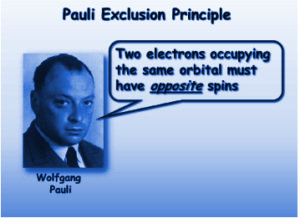Table of Contents
Introduction
Along with Aufbau’s Principle and Hund’s Rule, Pauli’s Exclusion Principle is an essential principle in chemistry. It is critical for pupils to understand, particularly while studying electrons. Pauli’s Exclusion Principle explains how electrons are arranged in atoms and molecules, as well as how elements are classified in the periodic table. In this section, we’ll look at the Pauli exclusion principle in-depth and learn about all of the principles that underpin it.
What is the Pauli Exclusion Principle, and how does it work?
- The Pauli exclusion principle asserts that no two electrons in a single atom will have the same set of quantum numbers (n, l, ml, and ms). To put it another way, each electron should have or be in its own distinct state (singlet state). The Pauli Exclusion Principle is based on two main principles:
- Only two electrons can be in the same orbital at the same time.
The spins of the two electrons in the same orbital must be opposing or they must be antiparallel.
Pauli’s Exclusion Principle, on the other hand, does not simply apply to electrons. It also applies to fermions and other half-integer spin particles.
Formulation of the Principle:
- The Pauli exclusion principle asserts that no two electrons in a single atom will have the same set of quantum numbers (n, l, ml, and ms). To put it another way, each electron should have or be in its own distinct state (singlet state). The Pauli Exclusion Principle is based on two main principles:
- Only two electrons can be in the same orbital at the same time.
The spins of the two electrons in the same orbital must be opposing or they must be antiparallel.
Pauli’s Exclusion Principle, on the other hand, does not simply apply to electrons. It also applies to fermions and other half-integer spin particles.
Nuclear Stability and Pauli Exclusion Principle:
- The Pauli exclusion principle asserts that no two electrons in a single atom will have the same set of quantum numbers (n, l, ml, and ms). To put it another way, each electron should have or be in its own distinct state (singlet state). The Pauli Exclusion Principle is based on two main principles:
- Only two electrons can be in the same orbital at the same time.
The spins of the two electrons in the same orbital must be opposing or they must be antiparallel.
Pauli’s Exclusion Principle, on the other hand, does not simply apply to electrons. It also applies to fermions and other half-integer spin particles.
Importance And Applications Of Pauli Exclusion Principle
- The Pauli exclusion principle can be used to explain a wide range of physical phenomena, including the geometry of atoms’ electron shells and how atoms share electrons.
- It aids in the description of the various chemical elements and their roles in the formation of chemical bonds.
- This method can also be used to define the periodic table.
- Properties of the Solid State: Pauli exclusion is the direct cause of many electrical, optical, magnetic, mechanical, and chemical phenomena in solids.
Quantum Numbers: An Overview
- Quantum numbers may completely define each electron in an atom. Quantum numbers are values that describe an electron’s state, such as its electron shell, orbital shape, orientation, and a number of orbitals, as well as its electronic spin. A total of four quantum numbers are employed.
- The quantum number n is the most important. It refers to the electron’s position in the innermost shell.
- The orbital angular momentum quantum number, l, aid in the determination of an orbital’s shape.
- The number of orbitals and their orientation is revealed by the magnetic quantum number, ml.
- The spin quantum number, abbreviated as ms, specifies the direction of electron spin.
FAQs
What Motivated Pauli to Create His Exclusion Rules?
There are many possibilities when looking at the configuration of electrons in an atom. However, electrons cannot be organised according to fundamental laws. The Aufbau principle and Hund's rule are known to govern the dispersion of electrons. However, because electrons have distinct spins, we must use Pauli's exclusion principle to arrange electrons in certain orbits.
What is the difference between Pauli's Exclusion Principle and Hund's Rule?
Hund's law describes how electrons can fill into two or more degenerate states in the presence of two or more degenerate states. Pauli's exclusion principle, on the other hand, gives an indication of the kind of electrons that can be packed together.
What is Quantum Mechanics, and how does it work?
Quantum Mechanics is a field of physics that studies the behaviour of matter and light at the subatomic and atomic levels. Everything follows the laws of quantum mechanics, but it's extremely difficult to see quantum effects in massive bodies, thus it was studied later.









